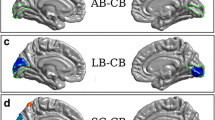Abstract
Different features of visual function mature along unique timescales through infancy and early childhood. It is not clear which functions continue to mature in school age children. Functions believed to be mediated by the Magnocellular (M) and Parvocellular (P) pathways were compared in five- (n=25), eight- (n=21) and eleven-year-old children (n=21) and young adult controls (n=20). Steady-state visual evoked potentials were recorded from occipital electrodes in response to very low spatial frequency gratings, at a series of contrasts (M), and to high contrast gratings at a series of spatial frequencies (P). No evidence was found to indicate M pathway development across these age groups. However, the youngest children demonstrated elevated VEP thresholds to the high contrast gratings compared with either the adults or eleven-year-olds. This difference in threshold implies an immaturity of the high contrast, high spatial frequency stream, i.e. the putative P pathway.
Similar content being viewed by others
References
Simmers AJ, Gray LS, Spowart K. Screening for amblyopia: a comparison of paediatric letter tests. Br J Ophthalmol 1997; 81: 465–9.
Bradley A, Freeman RD. Contrast sensitivity in children. Vision Res 1982; 22: 953–9.
Carkeet A, Levi DM, Manny RE. Development of Vernier acuity in childhood. Optom Vision Sci 1997; 74: 741–50.
Aso K, Watanabe K, Negoro T, Takaetsu E, Furune S, Izumi T, Yamamoto N, Nomura K. Developmental changes of pattern reversal visual evoked potentials. Brain Dev 1988; 10: 154–9.
McCulloch DL, Skarf B. Development of the human visual system: monocular and binocular pattern VEP latency. Invest Ophthalmol Vis Sci 1991; 32: 2372–81.
Sokol S, Jones K. Implicit time of pattern evoked potentials in infants: an index of maturation of spatial vision. Vision Res 1979; 19: 747–55.
DeVries-Khoe LH, Spekreise H. Maturation of luminance and pattern EPs in man. Doc Ophthalmol Proc Ser 1982; 31: 461–675.
Swanson WH, Birch EE. Infant spatiotemporal vision: dependence of spatial contrast sensitivity on temporal frequency. Vision Res 1990; 30: 1033–48.
Teller DY, Lindsey DT, Mar CM, Succop A, Mahal MR. Infant temporal contrast sensitivity at low temporal frequencies. Vision Res 1992; 32: 1157–62.
Rasengane TA, Allen D, Manny RE. Development of temporal contrast sensitivity in human infants. Vision Res 1997; 37: 1747–54.
Dannemiller JL, Freedland RL. Motion-based detection by 14-week-old infants. Vision Res 1993; 33: 675–64.
Zanker JM, Mohn G. On the development of motion perception in human infants. Clin Vision Sci 1993; 8: 63–71.
Kaufmann F. Development of motion perception in early infancy. Eur J Pediatr 1995; 154 (suppl 3): S48–S53.
Roessler JS, Dannemiller JL. Changes in human infants' sensitivity to slow displacements over the first 6 months. Vision Res 1997; 37: 417–23.
Merigan WH, Maunsell JHR. How parallel are the primate visual pathways? Ann Rev Neur 1993; 16: 369–402.
Huttenlocher PR, de Courten C. The development of synapses in striate cortex of man. Hum Neurob 1987; 6: 1–9.
Burkhalter A, Bernardo KL, Charles V. Development of local circuits in human visual cortex. J Neurosci 1993; 13: 1916–31.
Crewther SG. Crewther DP, Barnard N, Klistorner A. Electrophysiological and psychophysical evidence for the development of magnocellular function in children. Aust NZ J Ophthalmol (supplement) 1996; 24: 38–40.
Harding GFA, Odom JV, Spileers W, Spekreijse H. Standard for visual evoked potentials 1995. Vision Res 1996; 36: 3567–72.
Strasburger H. Analysis of steady state visual evoked potentials revisited. Clin Vision Sci 1987; 1: 245–56.
Albersheim WJ. A closed form approximation to Robertson's detection characteristics. Proc IEEE 1981; 69: 839.
Eizenmann M, Skarf B, McCulloch D, Katz L. New system for objective measurements of cortical binocularity in human infants. 4th International Evoked Potential Symposium, Toronto, Canada. October 3rd, 1990. (Conference presentation).
Boothe RG, Dobson V, Teller DY. Postnatal development of vision in human and non human primates. Ann Rev Neur 1985; 8: 495–545.
Hohmann A, Haase W. Development of visual line acuity in humans. Ophthalmic Res 1992; 14: 107–12.
Gordon GE. VEP investigations of parallel visual pathway function in children and groups at risk. PhD thesis, Glasgow Caledonian University, 1998.
Crognale MA, Kelly JP, Madrid M, Weiss AH. Changes in the chromatic visual evoked potential from one year until adulthood. Invest Ophthalmol Vis Sci 1998; 39: S1089.
Atkinson J, Braddick O, Braddick F. Acuity and contrast sensitivity of infant vision. Natur 1974; 247: 403–4.
Kelly JP, Borchet K, Teller DY. The development of chromatic and achromatic contrast sensitivity in infancy as tested with the sweep VEP. Vision Res 1997; 37: 2057–72.
Rights and permissions
About this article
Cite this article
Gordon, G.E., McCulloch, D.L. A VEP investigation of parallel visual pathway development in primary school age children. Doc Ophthalmol 99, 1–10 (1999). https://doi.org/10.1023/A:1002171011644
Issue Date:
DOI: https://doi.org/10.1023/A:1002171011644




